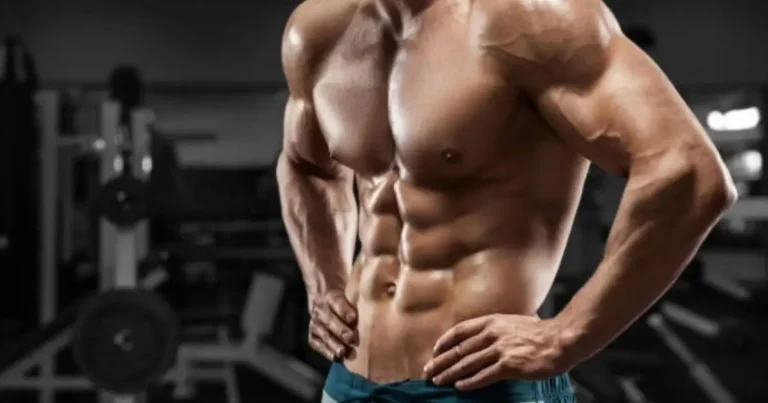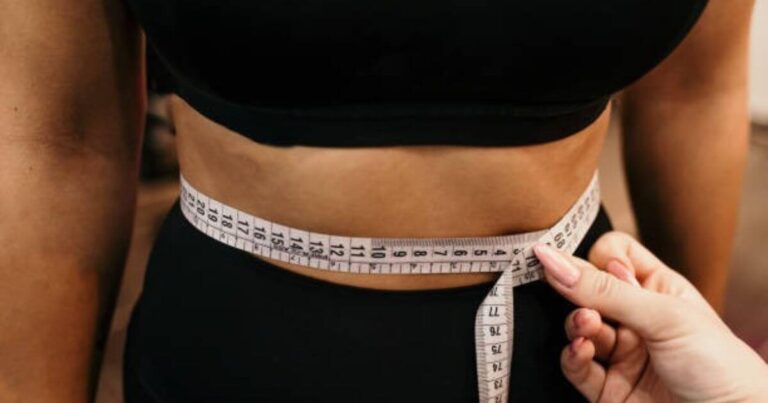The Ultimate Kettlebell Chest Workout for Strength & Definition
Are you looking to build impressive chest strength and definition using just kettlebells? You’ve come to the right place! Kettlebells offer a unique training stimulus that can transform your chest development while improving functional strength. Whether you’re working out at home with limited equipment or simply want to add variety to your gym routine, this comprehensive kettlebell chest workout guide will provide everything you need to succeed.
Table of Contents
Why Choose Kettlebells for Your Chest Workout? The Unique Advantages
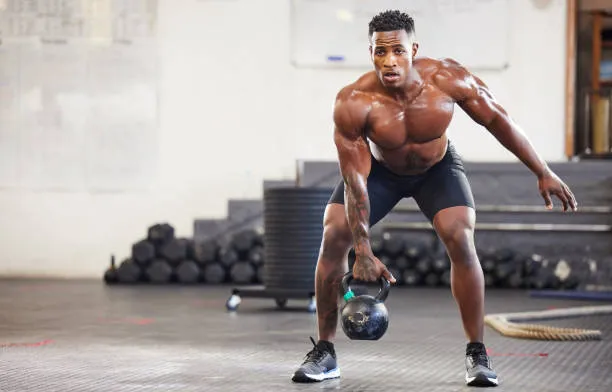
Traditional chest training typically revolves around barbells and dumbbells, but kettlebells offer distinct benefits that might be exactly what your training needs:
- Enhanced stabilizer muscle activation – The offset center of gravity in kettlebells creates instability that forces your stabilizing muscles to work harder, resulting in more complete chest development
- Improved grip strength – Every kettlebell chest exercise simultaneously builds crushing grip strength, which carries over to all other lifting
- Greater range of motion – Exercises like the kettlebell floor press allow for deeper stretches than traditional barbell variations
- Offset loading benefits – Single-arm kettlebell exercises create rotational resistance that engages your core and improves functional strength
- Versatility and space-efficiency – A pair of kettlebells requires minimal space yet provides dozens of chest exercise variations
While dumbbells and barbells excel at pure mass-building through stable, heavy loading, kettlebells shine in developing functional strength patterns and athletic performance. The best approach often combines multiple tools, but kettlebells alone can absolutely build an impressive chest when used correctly.
Essential Safety & Form Fundamentals for Kettlebell Chest Training
Before diving into specific exercises, mastering these fundamentals will keep you safe and maximize your results:
Proper Kettlebell Grip
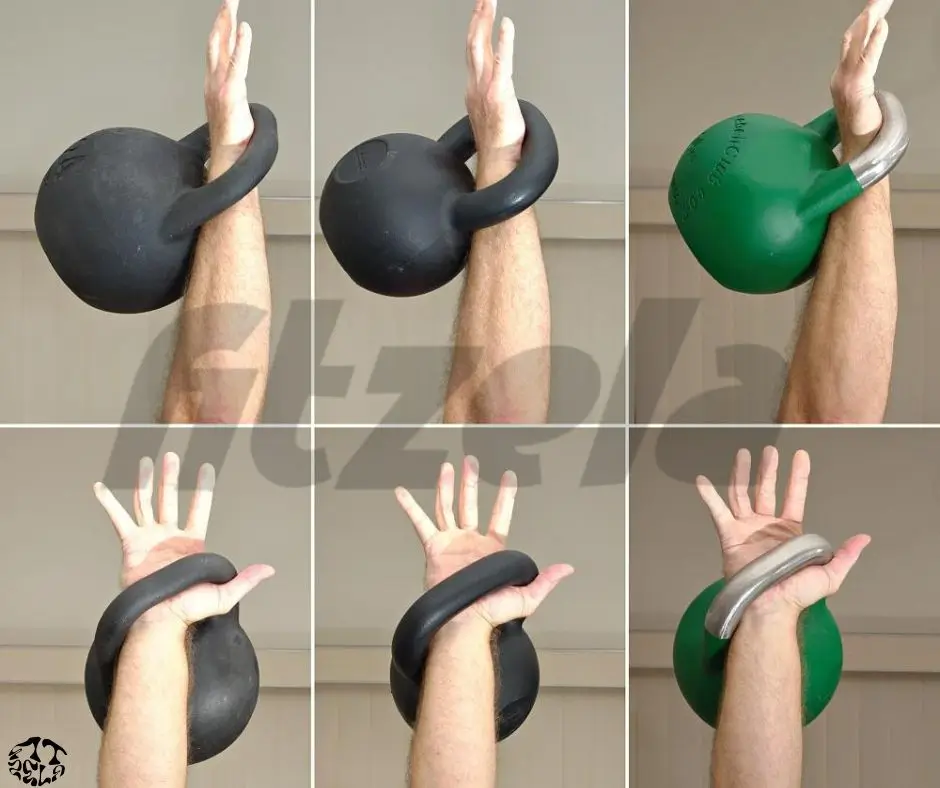
- Standard Grip: The handle rests diagonally across your palm with fingers wrapped around it
- Crush Grip: Actively squeeze the handle throughout the exercise to engage more muscles and improve stability
- Bottom-up Grip: Hold the kettlebell by the handle with the bell pointing upward (advanced technique that challenges stability)
Shoulder Packing and Scapular Stability
Proper shoulder position is crucial for kettlebell chest exercises:
- Pull your shoulders down away from your ears
- Squeeze your shoulder blades slightly back and down
- Maintain this position throughout pressing and flying movements
- Never allow shoulders to roll forward during exercises
Core Engagement and Neutral Spine
- Brace your abdomen as if preparing for a punch
- Keep your ribcage down (avoid excessive arching)
- Maintain a neutral spine position during all exercises
- For floor-based moves, press your lower back gently into the ground
Breathing Techniques
- Inhale during the eccentric (lowering) phase
- Exhale forcefully during the concentric (lifting) phase
- Never hold your breath for extended periods
- For maximum power, practice “power breathing” – a sharp exhale through pursed lips during the hardest part of the movement
The Best Kettlebell Chest Exercises
Kettlebell Floor Press
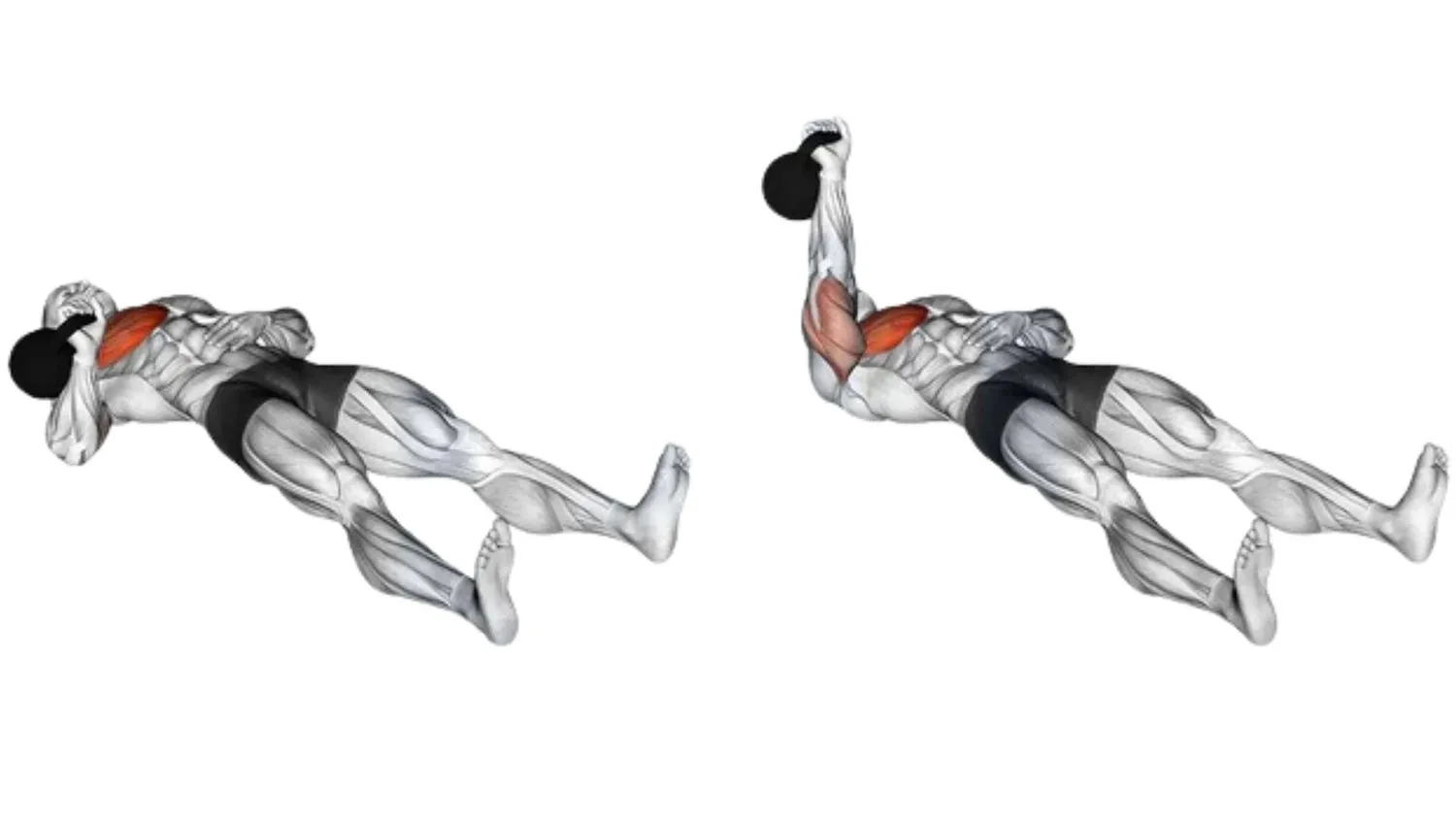
Target muscles: Primary – pectoralis major (chest); Secondary – anterior deltoids, triceps
Step-by-Step Instructions:
- Lie flat on your back with knees bent and feet flat on the floor
- Hold kettlebells at the shoulders, with wrists straight and elbows on the floor
- Press kettlebells straight up until arms are fully extended, with bells positioned over your shoulders
- Lower the kettlebells with control until elbows touch the floor
- Pause briefly at the bottom position before the next repetition
Pro Tips:
- Keep wrists straight throughout the movement
- Focus on squeezing your chest at the top of the movement
- Control the descent rather than letting gravity do the work
Variations:
- Single-arm floor press (increases core engagement)
- Alternating floor press (dynamic control challenge)
- Crush grip floor press (increased forearm/grip involvement)
Kettlebell Bench Press
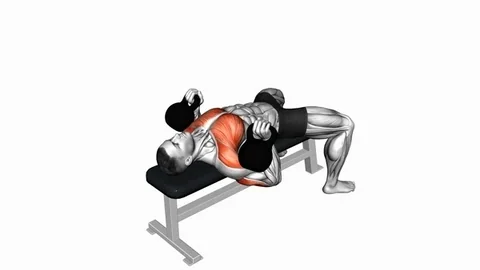
Target muscles: Pectoralis major, anterior deltoids, triceps
Step-by-Step Instructions:
- Lie on a flat bench with feet firmly on the floor
- Hold kettlebells at chest level, bells resting against your forearms
- Press kettlebells upward until arms are fully extended
- Lower with control to starting position at chest level
- Maintain a slight arch in your lower back throughout
Pro Tips:
- Keep elbows at approximately 45° from your body (not flared wide)
- Squeeze your chest at the top of the movement
- For safety, use a spotter or start with lighter weights than you would with dumbbells
Variations:
- Incline bench press (targets upper chest)
- Decline bench press (emphasizes lower chest)
- Close-grip bench press (greater triceps emphasis)
Kettlebell Floor Fly
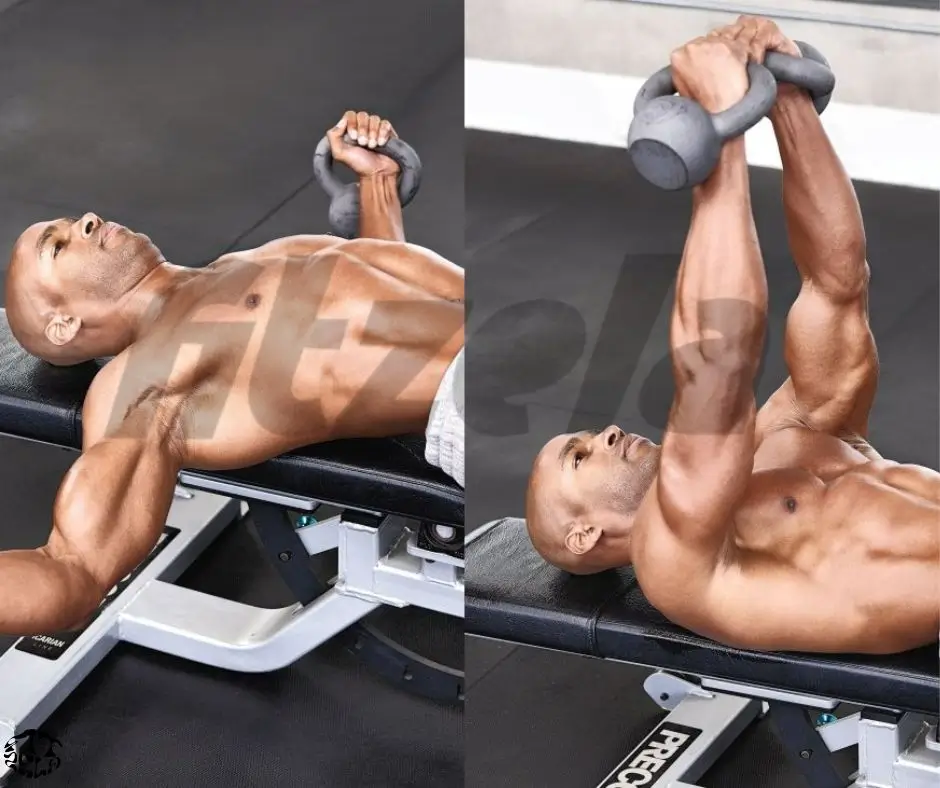
Target muscles: Pectoralis major (chest), particularly the outer portions
Step-by-Step Instructions:
- Lie on your back with knees bent and feet flat
- Hold kettlebells directly above chest with palms facing each other and a slight bend in the elbows
- Lower kettlebells outward in a wide arc while maintaining elbow position
- Stop when upper arms reach floor level
- Squeeze chest muscles to bring kettlebells back together in the same arc motion
Pro Tips:
- Maintain a consistent slight bend in your elbows throughout
- Focus on the stretch across your chest during the lowering phase
- Move through a complete range of motion without compromising form
Variations:
- Single-arm floor fly (increased core activation)
- Alternating floor fly (coordination challenge)
Kettlebell Push-Up Variations
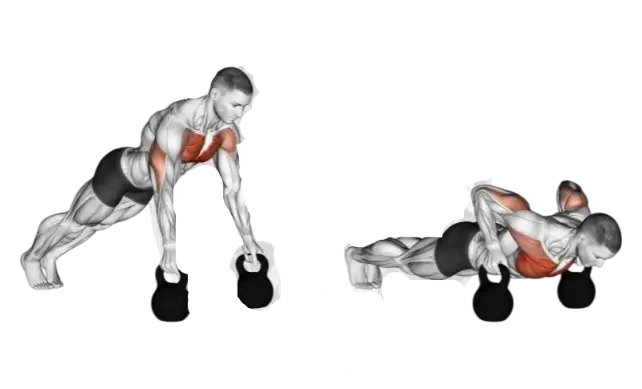
Target muscles: Pectoralis major, anterior deltoids, triceps, core
Hands on Kettlebell Handles
Step-by-Step Instructions:
- Place two kettlebells shoulder-width apart, handles parallel
- Get into a push-up position with hands gripping the handles
- Lower your body with control until chest nearly touches the floor
- Press back up to the starting position
- Maintain a straight line from head to heels throughout
Pro Tips:
- The unstable base requires greater stabilization through your shoulders and core
- Squeeze your glutes and brace your core throughout the movement
- Keep elbows at roughly 45° to your body, not flared wide
Hands on Kettlebell Bells
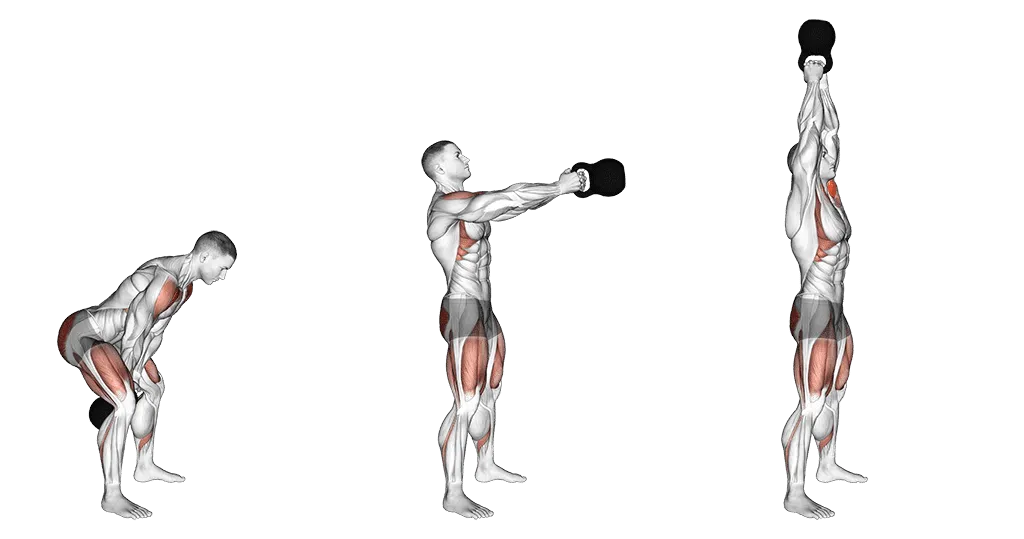
Step-by-Step Instructions:
- Place two kettlebells on the floor with the bell portion (round part) facing down
- Position hands on top of the bells, directly under shoulders
- Perform push-ups while balancing on the rounded surface
- Maintain a straight body line throughout the movement
Pro Tips:
- This is an advanced variation requiring significant stability
- Start with standard push-ups before progressing to this version
- Focus on maintaining total body tension throughout the movement
Kettlebell Pullover

Target muscles: Pectoralis major (lower portion), latissimus dorsi, serratus anterior
Step-by-Step Instructions:
- Lie on your back on a bench or floor, knees bent if on floor
- Hold a single kettlebell with both hands around the handle
- Extend arms over chest, keeping a slight bend in elbows
- Lower kettlebell back and over your head in a controlled arc
- Stop when you feel a stretch in your chest and lats
- Pull the kettlebell back to the starting position, focusing on chest engagement
Pro Tips:
- For more chest engagement, keep elbows slightly wider
- For more lat engagement, keep elbows closer together
- Maintain core engagement to protect your lower back
How to Structure Your Kettlebell Chest Workout
Choosing the Right Kettlebell Weight
| Experience Level | Recommended Weight (Men) | Recommended Weight (Women) |
| Beginner | 12-16kg (26-35lbs) | 8-12kg (18-26lbs) |
| Intermediate | 20-24kg (44-53lbs) | 12-16kg (26-35lbs) |
| Advanced | 28-32kg+ (62-70lbs+) | 20-24kg+ (44-53lbs+) |
These are general guidelines – adjust based on your individual strength levels. When in doubt, start lighter and focus on perfect form before increasing weight.
Sets, Reps, and Rest Periods
| Goal | Sets | Reps | Rest Period | Tempo |
| Strength Building | 4-6 | 4-6 | 2-3 min | Controlled, deliberate |
| Hypertrophy | 3-4 | 8-12 | 60-90 sec | Moderate |
| Endurance | 2-3 | 15-20 | 30-45 sec | Quicker, continuous |
| Power Development | 3-5 | 3-5 | 2-3 min | Explosive concentric |
Workout Frequency Recommendations
For optimal chest development with kettlebells:
- Beginners: 2 dedicated chest workouts per week with at least 48 hours recovery between sessions
- Intermediate: 2-3 chest workouts weekly, potentially using different intensity techniques
- Advanced: Up to 3-4 chest-focused sessions, with variation in volume and intensity
Always prioritize recovery – muscles grow during rest, not during training. If you’re still sore from a previous workout, allow more recovery time.
Sample Kettlebell Chest Workout Routines
Beginner Routine
Focus: Mastering form, building foundational strength
Equipment: 1-2 kettlebells of appropriate weight
- Kettlebell Floor Press – 3 sets of 8 reps (each side if single)
- Kettlebell Push-Ups (hands on floor, feet elevated on bell) – 3 sets of 8-10 reps
- Kettlebell Pullover – 3 sets of 10 reps
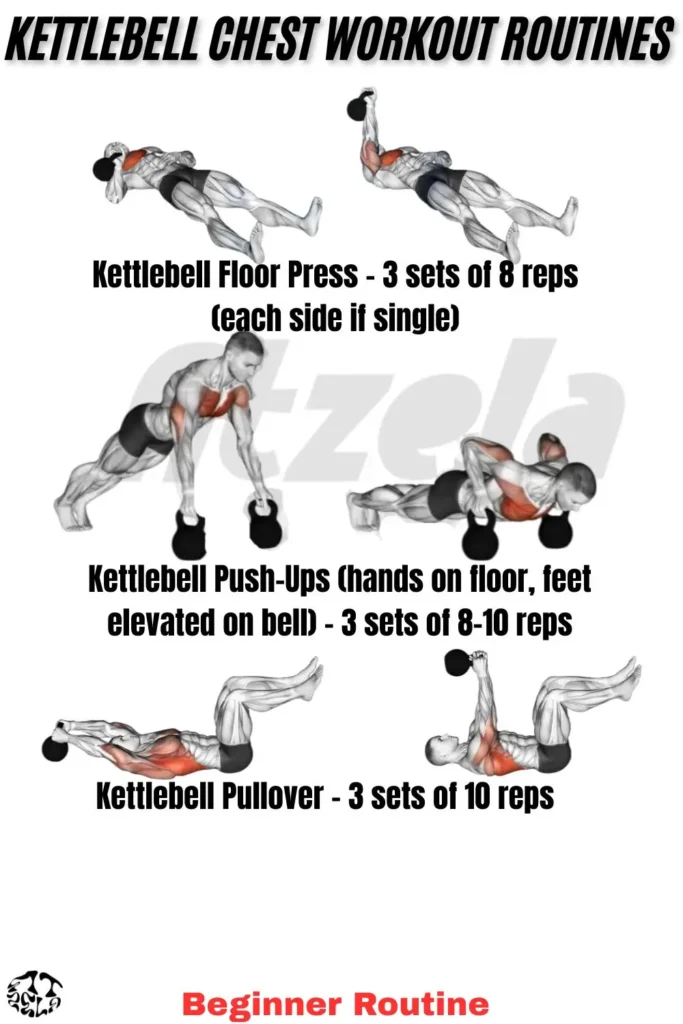
Rest 90 seconds between sets. Complete this workout twice weekly with at least 48 hours between sessions.
Intermediate Routine
Focus: Building chest size and strength
Equipment: 2 kettlebells (matching pair recommended)
- Kettlebell Bench Press – 4 sets of 8 reps
- Kettlebell Floor Fly – 3 sets of 10 reps
- Kettlebell Push-Ups (hands on handles) – 3 sets of 12 reps
- Single-Arm Kettlebell Floor Press – 3 sets of 8 reps per arm
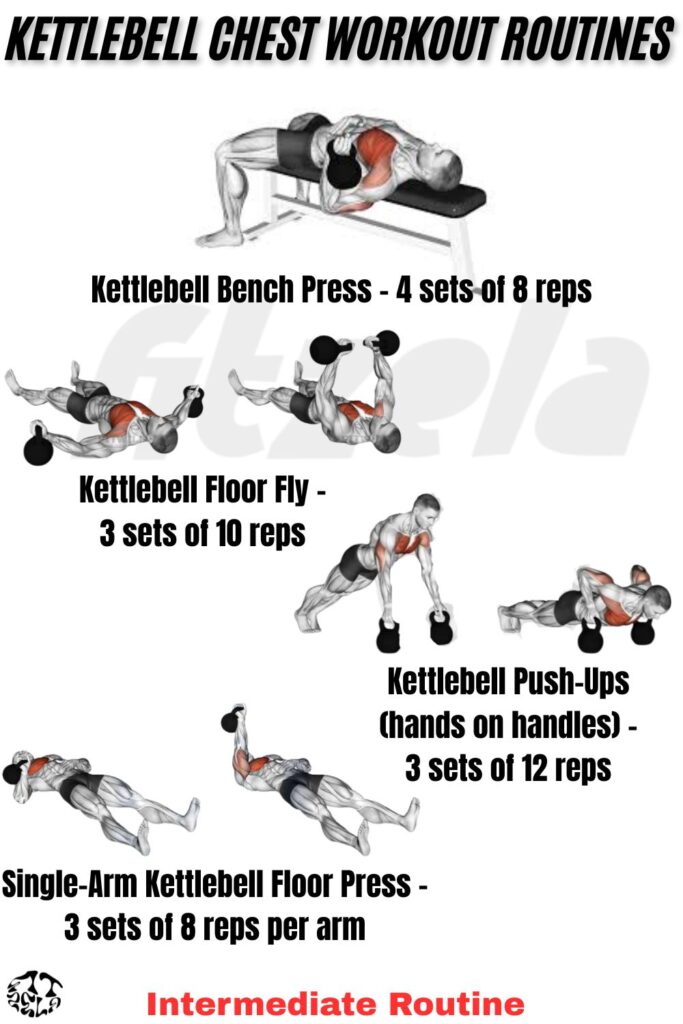
Rest 60-75 seconds between sets. Complete 2-3 times weekly.
Advanced Routine
Focus: Maximum chest development and definition
Equipment: Multiple kettlebells of varying weights
- Kettlebell Bench Press – 5 sets of 5 reps (heavy)
- Kettlebell Push-Ups (hands on bells) – 4 sets of 8-10 reps
- Kettlebell Floor Press/Floor Fly Superset:
- Floor Press – 3 sets of 8 reps
- Floor Fly – 3 sets of 12 reps
- (No rest between exercises, 90 seconds rest after completing both)
- Single-Arm Kettlebell Floor Press – 3 sets of 8 reps per side
- Kettlebell Pullover – 3 sets of 12 reps
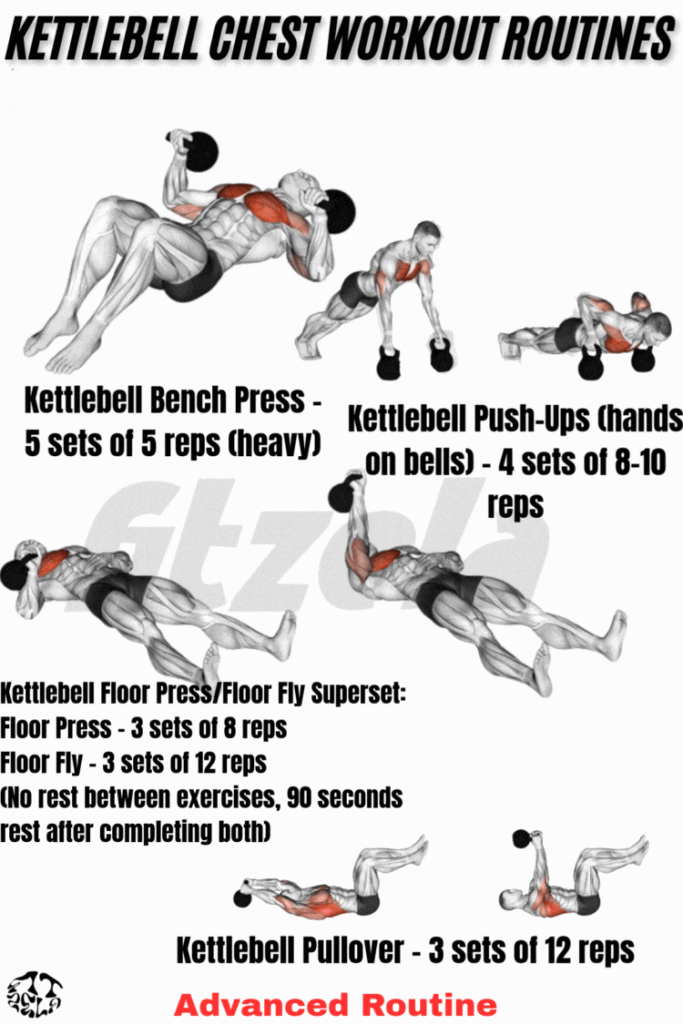
Complete this workout 2-3 times weekly with appropriate recovery.
Minimalist Home Workout (1-2 Kettlebells)
Focus: Maximum results with minimal equipment
Equipment: 1-2 kettlebells
- Kettlebell Push-Ups (hands on floor, feet elevated) – 3 sets of 12 reps
- Single-Arm Kettlebell Floor Press – 3 sets of 8 reps per arm
- Kettlebell Pullover – 3 sets of 12 reps
- Push-Up/Floor Press Ladder:
- Start with 10 push-ups
- Immediately do 10 floor presses
- Without rest, do 9 push-ups
- Follow with 9 floor presses
- Continue down to 1 rep of each
This efficient workout can be performed 2-3 times weekly in under 30 minutes.
Common Kettlebell Chest Training Mistakes (And How to Fix Them)
| Common Mistake | Problem | Solution |
| Flaring elbows too wide | Puts excessive stress on shoulder joints | Keep elbows at roughly 45° angle from body |
| Arching lower back excessively | Reduces chest engagement, risks back injury | Maintain neutral spine, brace core |
| Using momentum, not muscles | Reduces effectiveness, increases injury risk | Control each rep, focus on muscle engagement |
| Inconsistent kettlebell path | Reduces stability and muscle recruitment | Follow the same path for each repetition |
| Inadequate range of motion | Limits muscle development | Move through full range without compromising form |
| Neglecting proper warm-up | Increases injury risk | Perform dynamic mobility work and lighter sets before heavy work |
Progressing Your Kettlebell Chest Training
To continue making gains with kettlebell chest training, implement these progression strategies:
- Increase weight – The most straightforward approach, but often requires purchasing new kettlebells
- Increase volume – Add sets and/or reps before moving to heavier weights
- Decrease rest periods – Gradually reduce rest between sets to increase workout density
- Improve technical mastery – Focus on perfect form, controlled eccentrics, and peak contractions
- Incorporate advanced techniques:
- Tempo training (slow negatives, pauses)
- Drop sets (switching to lighter kettlebells when fatigued)
- Pre-exhaustion (isolation exercises before compound movements)
- Post-exhaustion (compound movements before isolation)
Remember: Progression should be systematic and gradual. Track your workouts to ensure you’re continuously challenging yourself while maintaining good form.

Frequently Asked Questions (FAQ)
Can you really build a big chest with only kettlebells? Yes, kettlebells can absolutely build significant chest mass and strength when used properly. The key is progressive overload, sufficient volume, and proper nutrition. While very advanced bodybuilders might eventually need additional tools, kettlebells alone can take most people very far in their chest development.
What size kettlebell should I start with for chest exercises? Most men should start with 16kg (35lbs) for pressing movements, while most women should begin with 8-12kg (18-26lbs). These weights allow you to learn proper form before advancing to heavier loads. For push-up variations, bodyweight is often sufficient to start.
Are kettlebells better than dumbbells for chest? Neither is universally “better” – they’re different tools with different strengths. Kettlebells excel at creating instability and engaging stabilizer muscles, while dumbbells typically allow for heavier loads and more controlled movements. For optimal development, incorporating both can be beneficial, but kettlebells alone provide plenty of stimulus for growth.
How often should I do a kettlebell chest workout? For most people, 2-3 dedicated chest workouts per week is optimal, allowing for 48-72 hours of recovery between sessions. Your exact frequency should be based on your recovery ability, overall training volume, and goals.
Can I combine kettlebell chest exercises with other training? Absolutely! Kettlebell chest exercises integrate well with bodyweight training, barbell work, or other kettlebell exercises. Just be mindful of total training volume and ensure adequate recovery.
Conclusion
Kettlebell training offers a unique and effective approach to chest development that can build impressive strength, definition, and functional fitness. The unstable nature of kettlebells engages stabilizer muscles that traditional training might miss, resulting in more complete development and potentially reducing injury risk.
Remember that consistency is key – follow the progressive routines outlined above, focus on perfect form before increasing weight, and give your body adequate nutrition and recovery time. Whether you’re training at home with minimal equipment or looking to add variety to your gym routine, kettlebells can transform your chest training.
Ready to get started? Choose one of the sample routines that matches your experience level, grab your kettlebells, and begin your journey to a stronger, more defined chest!
What’s your experience with kettlebell training for chest? Share your results or questions in the comments below!



